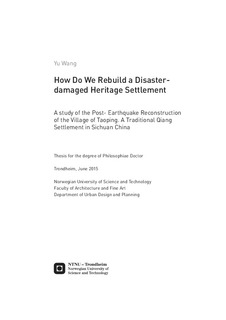| dc.contributor.author | Wang, Yu | |
| dc.date.accessioned | 2015-10-30T10:13:10Z | |
| dc.date.available | 2015-10-30T10:13:10Z | |
| dc.date.issued | 2015 | |
| dc.identifier.isbn | 978-82-326-1029-7 | |
| dc.identifier.issn | 1503-8181 | |
| dc.identifier.uri | http://hdl.handle.net/11250/2358710 | |
| dc.description.abstract | This research is about post-disaster reconstruction of culture heritage settlements, not
as an activity but conceptually, by addressing the question of how do we preserve a
heritage settlement damaged by disaster? Underpinning that issue is a case study of
Taoping Qiang Village. Taoping is a Qiang Minority’s traditional settlement which
went through a post-earthquake reconstruction from 2008 to 2011 in Sichuan, China.
In my thesis heritage settlement is understood as “lived-in cultural heritage
settlements”. The “lived-in” situation refers to heritage settlements which suspends
the natural coherence between inhabitants and dwellings. This coherence refers to
settlements renovate and maintenance according to their needs and wills of their
inhabitants. Which in turn are driven by their livelihoods, social practices and living
habitus etc. “Lived-in” heritage illustrates a state in which the protected old dwellings
host a present-day mode of living. “Lived-in” heritage also displays the coexistence of
habitation and conservation. Furthermore it implies a complicated relationship
between those two actives.
To rebuild a heritage settlement after disaster is not only to rescue the damaged
historical buildings but also to reestablish the homes of the inhabitants. This research
is built on that recognition and regards the local community as a key player in the
reconstruction of heritage settlements. To understand possible behavior and reaction
of the community to the reconstruction we need to know its social context. Hence my
research employs “modernity” and “citizenship” in order to set up a “reference frame”.
The extent of modernity and state of citizenship substantially impact the underlying
attitude and reactions of the community.
I employ a three-stage investigation in the Taoping case, those of past, present, future.
Phase one covers the two uncoordinated “reconstructions” of Taoping, the official
reconstruction and the subsequent self-restoration. The reason for the latter was the
failure of the first to recognize the key role of the community. They focused on
rebuilding homes rather than saving heritage. In stage two I focus on the
reconstruction’s impact on the present-day life of the community. (Re)building on
agricultural land forced the local community to alter their means of livelihood, from agricultural to tourism. Hence the village of Taoping was converted from an old
village into a tourist attraction, a showcase of traditional Qiang life. Consequently
those activities devalued the heritage settlement. In stage three I discuss the resilience
of the reconstructed Taoping and how they can meet natural hazards in the future. The
models of testing the resilience of Taoping show that Taoping is still vulnerable to
seismic hazards and extreme-weather-caused floods and landslides.
My study shows that the Taoping community was not to take part in the official
reconstruction because of the top-down policymaking regime and current state of
citizenship, inhabiting the inhabitants to wield their rights. Livelihood shifts may
benefit the social modernization and enhance the community’s economic citizenship,
however, it neglects the development of a culture of modernity and the responsibility
of citizenship. The fact that Taoping remains vulnerable to hazards is the consequence
of a reconstruction that did not recognize the complexity of a “lived-in” state.
The insights gained through this research highlight that heritage settlement
conservation after disaster inevitably have to consider the interaction between
habitation and conservation. To clarify the relationship between community and the
historical dwellings is crucial. So is the risk assessment in order to enhance the
resilience and thus secure the future of rebuilt heritage settlement. | nb_NO |
| dc.language.iso | eng | nb_NO |
| dc.publisher | NTNU | nb_NO |
| dc.relation.ispartofseries | Doctoral thesis at NTNU;2015:186 | |
| dc.relation.haspart | Appendix 1:
“Modernity and Cultural Heritage Conservation”
in the Chinese journal, Community Design 03/2014 (61), (p.34-p.37) | |
| dc.relation.haspart | Appendix 2:
Wang, Yu; Skotte, Hans.
Reconstruction after Reconstruction: A Study of the Post-Earthquake Reconstruction of Taoping Village, a Traditional Qiang Settlement in Sichuan, China. I: Rebuilding Sustainable Communities after Disasters in China, Japan and Beyond. Cambridge Scholars Publishing 2014. s. 45-61 | |
| dc.relation.haspart | Appendix 3:
“Reshaping Place, Reshaping People? The Social Impact of the Reconstruction
Strategy Applied in Reconstructing the Qiang Village of Taoping Following the 2008
Sichuan Earthquake”
published in the conference proceeding of The 2nd Biennial Conference on
Anthropology and Sustainability 2014 p.91-96 | |
| dc.relation.haspart | Appendix 4:
“Still at Risk? After Recosntruction: How does the Mode of Reconstruction Cause New
Vulnerabilities when Rebuilding a Vernacular Cultural Heritage Settlement.”
accepted as a book chapter in Planning for Community-based Disaster Resilience Worldwide:
Learning from Case Studies in Six Continents. Awotona, A. ed. Ashgate Publishing Limited | |
| dc.relation.haspart | Appendix 5:
Appendix V
“A Sustainable Approach for Post-disaster Rehabitation of Rural Settlement Heritage”
as published in a conference proceeding of 20th Annual International Sustainable Development
Conference Norwegian University of Science and Technology, Trondheim, Norway June 18-20,
2014. (p.289-p.296) Second edition is accepted to the journal, Sustainable Development | |
| dc.relation.haspart | Appendix 6:
Design Documents for Heritage Reconstruction of Taoping (excerpts)
by Chinese Architecture History Research Institute | |
| dc.title | How Do We Rebuild a Disaster damaged Heritage Settlement: A study of the Post- Earthquake Reconstruction of the Village of Taoping. A Traditional Qiang Settlement in Sichuan China | nb_NO |
| dc.type | Doctoral thesis | nb_NO |
| dc.subject.nsi | VDP::Social science: 200::Urbanism and physical planning: 230 | nb_NO |

